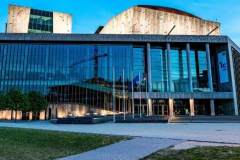Camilla Nylund and Helmut Deutsch, Song Recital
June 2026 | ||||||
|---|---|---|---|---|---|---|
Mo | Tu | We | Th | Fr | Sa | Su |
Known for her sensitive interpretation of roles, the Finnish soprano Camilla Nylund will once again demonstrate in this evening of lieder what an outstanding performer of the German repertoire she is. In addition to Wagner, Richard Strauss and the Austrian Alban Berg, she will also perform some Dvořák alongside a selection of works from arguably her homeland’s most popular composer, Jean Sibelius. Just as the Budapest audience will have already encountered the singer as Elsa in Lohengrin and Sieglind in Die Walküre, as well as in song recitals, her partner should be equally familiar. Helmut Deutsch is considered one of the world’s finest lieder accompanists and most recently appeared at Müpa Budapest alongside Diana Damrau and Jonas Kaufmann in April 2025.
Program and cast
soprano: Camilla Nylund
piano: Helmut Deutsch
Program
Dvořák
Gypsy Songs, Op. 55
Wagner
Gretchen am Spinnrade (Gretchen at the Spinning Wheel), WWV 15
Wagner
Tout n’est qu‘images fugitives (All is But Fleeting Images), WWV 58
Wagner
Attente (Waiting), WWV 55
Berg
Seven Early Songs
Sibelius
Illalle (To Evening), Op. 17, No. 6
Sibelius
Norden (The North), Op. 90, No. 1
Sibelius
En slända (A Dragonfly), Op. 17, No. 5
Sibelius
Soluppgång (Sunrise), Op. 37, No. 3
Sibelius
Höstkväll (Autumn Evening), Op. 38, No. 1
R. Strauss
Lob des Leidens (In Praise of Suffering), Op. 15, No. 3
R. Strauss
Die Nacht (The Night), Op. 10, No. 3
R. Strauss
Die Georgine (The Dahlia), Op. 10, No. 4
R. Strauss
Allerseelen (All Soul’s Day), Op. 10, No. 8
R. Strauss
Wer hat’s getan (Who Did It?), Op. 84A
R. Strauss
Wie sollten wir geheim sie halten (How Could We Keep it Secret?), Op. 19, No. 4
Palace of Arts Müpa Budapest
When Müpa Budapest, Hungary and its capital's new cultural hub, opened in 2005, it was built to represent more than 100 years of Hungarian cultural history. As a conglomeration of cultural venues, the building has no precedent in 20th century Hungarian architecture and has no peers in the whole of Central Europe.
The creators of this ambitious project, the Trigránit Development Corporation, prime contractor Arcadom Construction and the Zoboki, Demeter and Partners Architectural Office, were driven by the desire to create a new European cultural citadel as part of the new Millennium City Centre complex along the UNESCO World Heritage-listed Danube waterfront. The result is a facility whose construction quality, appearance, functionality and 21st century technological infrastructure makes it ideally suited to productions of the highest standard. The building is also highly versatile and equipped to host performances of any genre and almost any scale.

 EN
EN DE
DE IT
IT FR
FR ES
ES RU
RU JP
JP RO
RO
 Seating plan
Seating plan 
